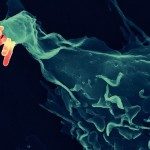Link to Pubmed [PMID] – 19135407
Curr. Opin. Microbiol. 2009 Feb;12(1):24-30
Secretion and translocation of bacterial pathogen effectors into host cells via dedicated secretion machineries like type III secretion systems (T3SSs) or type IV secretion systems (T4SSs) is a key feature employed by pathogens to attack host cells. Innovative fluorescence and imaging approaches have blossomed during recent years, and became instrumental in revealing the dynamics of effector secretion and function in interfering with host cellular processes, particularly signaling events, gene expression regulation, membrane trafficking, and autophagy. Furthermore, imaging-based screening approaches have demonstrated the mode of action of several bacterial effectors upon host cellular translocation. The rapid technological advancement of imaging technologies indicates that these techniques will continue to be at the center of numerous future breakthroughs delineating the dynamic processes of bacterial effector actions.

